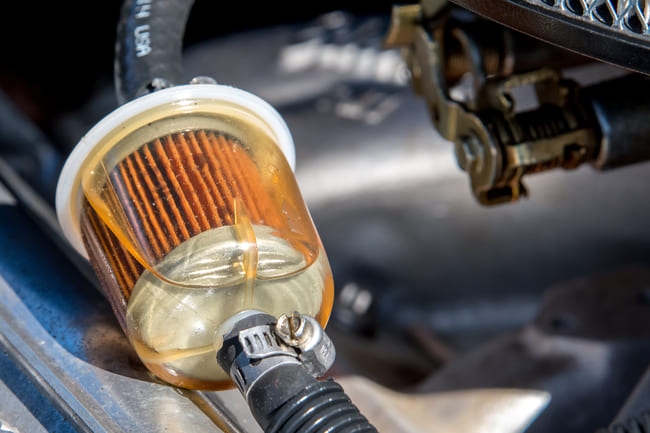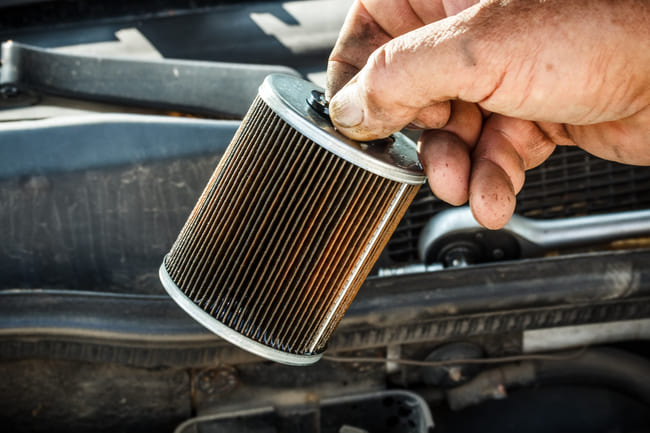
Unfiltered fuel can be contaminated with dirt particles, rust, paint particles or water, although nowadays fuel quality, especially in Western Europe, is high by default. It is important to remove these substances before fuel enters the engine to prevent wear and tear and failure of the injection system or fuel pump, which can be caused by clogged nozzles or the dirt particles themselves. To prevent this, every internal combustion engine is fitted with a fuel filter. Over time, the fuel filter can become clogged, which is why it needs to be changed regularly. If you keep to the maintenance intervals of your car, the filter will be changed in good time during the inspections. Of course you can also do this yourself. This article explains how this works and what symptoms indicate a clogged fuel filter.
Contents
Structure and tasks of a fuel filter

The task of the fuel filter is to remove dirt particles such as rust, paint, pollen and other impurities from the fuel before it is fed into the engine. The fuel filters of modern injection systems have to meet very high requirements, since these systems require a very high degree of fuel purity. Even the smallest dirt particles can cause major damage here, as they can lead to malfunctions or failure of the injection systems. In addition, the filters must have a high tolerance to modern fuels with a high biodiesel or ethanol content and to temperatures in the range of -40 °C to 100 °C in order to guarantee a constantly high filter performance and flow rate. In addition, the fuel filters must be designed in such a way that they do not burst in the event of an accident, causing fuel to escape.
Fuel filters come in a variety of shapes. A distinction is made between fuel filter elements, spin-on fuel filters and fuel line filters. The fuel filter elements are installed in the engine with their own housing. A spin-on fuel filter can also contain additional functions, such as a connection piece for a fuel heater, a water drain plug or a water level indicator. The fuel line filter (inline) is installed directly in the fuel line and can be made of steel, aluminum or plastic. During maintenance, all three types are replaced as a unit consisting of housing and filter element.
In addition to the different designs, a distinction must also be made between petrol filters and diesel filters. In contrast to the petrol filter, which is usually located as an intermediate piece in the fuel line, the diesel filter is an independent component that is installed in the engine compartment. The diesel enters the filter through a connection at the top end, is cleaned and then sent to the engine through a second connection. As a result, the filter paper (membrane inside the filter) becomes increasingly clogged with dirt particles and impurities, eventually making it necessary to replace the fuel filters.
Symptoms of a clogged fuel filter

When a fuel filter needs to be changed depends on various factors that mean that the filter can no longer clean the fuel sufficiently because its absorption capacity has been reached.
These factors include:
- Fuel Quality
- annual mileage
- Age of wear parts
Normally it is quite sufficient to change the fuel filter as part of the inspection and maintenance intervals. However, it can happen that the filter becomes clogged earlier and therefore needs to be replaced sooner in order to avoid engine damage in the worst case.
A clogged diesel or petrol filter can be recognized by the following symptoms:
- ! Vehicle jerking when accelerating
- ! Loss of performance
- ! Check engine light comes on

- ! poor throttle response when accelerating
- ! Problems starting the engine
- ! Engine stops while driving for no apparent reason
Consequences of a blocked fuel filter
Even if these signs do not seem so serious at first glance, you should still check promptly whether these symptoms are due to a clogged fuel filter. A lack of fuel leads to unclean combustion in the engine, which means that it produces more pollutants and more and more soot. This can cause harmful deposits and, in the worst case, engine damage. This also impedes the flow of fuel, which means that the engine only delivers reduced performance and no longer runs smoothly. Driving for too long with a clogged fuel filter can result in consequential damage such as faster wear and clogging of the injectors and injection nozzles, which in turn would require additional work and additional costs to clean.
Change fuel filter

Since the fuel filter is subject to natural wear due to clogging, it must be changed at regular intervals, usually between 30,000 and 90,000 km, depending on the fuel quality, vehicle manufacturer and filter type. This is usually done in the course of the prescribed inspections and maintenance work. Due to the easy accessibility in most cars, you can also change the fuel filter yourself. All you need are the following tools: screwdriver, wrench, rag or cloth, hoist or pit for changing the fuel filter, container to collect the fuel, gloves and safety goggles.
Proceed as follows to change the fuel filter:
- Preparation: Find a place that has adequate ventilation and where there are no sources of ignition, as the highly flammable fuel may spill when you change the filter. As it is a hazardous substance, it does not belong down the drain, so have a clean container ready to catch the fuel.
- Find the fuel filter: Make sure the car is cool before you start work. The parts in the engine compartment can be very hot and must not be touched. The petrol filter is usually located in the fuel line on the vehicle floor near the driver's seat, while the diesel filter is located in the engine compartment.
- Detaching the fuel filter: It is a good idea to take a picture before starting work so that you can then reattach the lines exactly as they were before. Now loosen the screw to remove the bracket or clamp that secures the filter.
- Detaching the lines: When detaching the lines, fuel escapes, which under no circumstances must come into contact with the skin. Therefore, you should wear gloves and safety goggles and use a sufficiently large container to catch the fuel. Now pull off the lines. If these are stuck, you can use a screwdriver to help.
- Disassembly and assembly of the new filter: Work quickly so that as little fuel as possible escapes. Remove the old filter and insert the new one. The installation direction of the new fuel filter is marked with an arrow, which must point from the tank to the engine. Push the lines back on just as far as they were on the old filter. Install the clamp and tighten once you are sure the filter and tubing are in the correct position.
- Fill filter with fuel and test: Switch on the ignition 3 times for 30 seconds, the lights and the on-board computer should come on, but the engine should not start yet. This activates the pump to draw fuel from the tank. Then start the car. It may take several attempts to do this as the air has yet to be forced out of the system. The starter should be operated for a maximum of a few seconds at a time, followed by a 10-second pause, so as not to put too much strain on the cables and battery. If the car starts after a few tries, your job was successful and you can fill the previously spilled fuel into the tank or, if it is dirty, dispose of it according to regulations.
Conclusion
Since the fuel filter becomes more and more clogged over time and eventually clogged, it must be changed at regular intervals to avoid consequential damage such as clogged injector nozzles and engine damage. How often the fuel filter of your diesel or petrol engine needs to be changed depends heavily on the filter type, vehicle and fuel quality. The filter can be changed relatively easily and quickly by yourself. However, if you do not dare to change the petrol or diesel filter yourself, you can of course have this done in a workshop. However, higher costs are incurred here, since in addition to the pure material costs (petrol filter in original equipment manufacturer quality from 35 euros and diesel filter from 20 euros) there are of course also the costs for the workload, since the pure filter change also includes bleeding, draining and filling with fuel. Depending on the installation position of the filter, an expert needs between 30 and 60 minutes for this, which is why costs totaling 120 to 230 euros can be expected.
